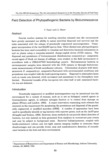Field Detection of Phytopathogenic Bacteria by Bioluminescence
JIRCAS international symposium series
| ISSN | 13406108 |
|---|---|
| 書誌レコードID(総合目録DB) | AA1100908X |

本文フルテキスト
intlsymp-5_83-89.pdf218.69 KB
Genetic marker systems for tracking microbes released into the environment have greatly increased our ability to assess microbial dispersal and survival and the risks associated with the release of genetically engineered microorganisms. Trans-genic incorporation of the luxCDABE operon from Vibrio fischeri into phytopathogenic bacteria has been used successfully to visualize and determine bacterial colonization in and on plants using a computer-assisted, charge-oupled device (CCD) camera. The dispersal and persistence of bioluminescent Xanthomonas campestris pv. campestris, causal agent of black rot disease of cabbage, were studied in the field environment in accordance with a USDA/APHIS biotechnology permit. Bioluminescent bacteria in environmental samples were detected with the CCD camera or through bioluminescence measurements of broth enrichment cultures. Colonization of plants with bioluminescent X campestris pv. campestris fluctuated with environmental conditions and persistence was coupled with the host's growing season. Dispersal to alternative hosts such as weeds was detected, while movement and persistence in the rhizosphere were limited. Horizontal transfer of the lux operon into other leaf- or soil- associated bacteria was not detected.
| 作成者 | F. Dane J.J. Shaw |
|---|---|
| 公開者 | Japan International Research Center for Agricultural Sciences |
| オンライン掲載日 | |
| 号 | 5 |
| 開始ページ | 83 |
| 終了ページ | 89 |
| 言語 | eng |
